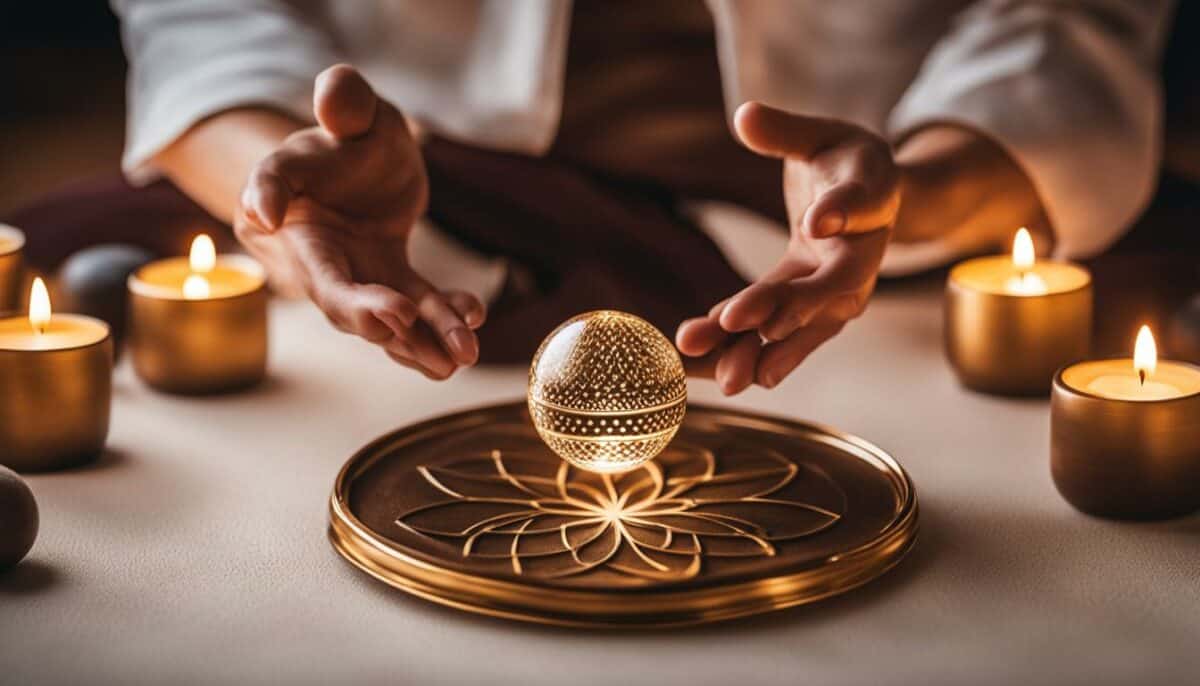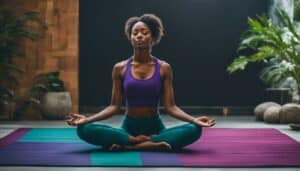Do you suffer from chronic pain, stress, or anxiety? Are you looking for alternative healing methods to complement your traditional medical treatments? If so, Reiki and Acupressure may be just what you need.
Reiki and Acupressure are powerful energy healing practices that have been used for centuries to promote physical, emotional, and spiritual well-being. By combining these holistic healing techniques, you can tap into your body’s natural ability to heal itself and achieve a greater sense of balance and harmony.
In this article, we will explore the benefits of combining Reiki and Acupressure, how to integrate these practices into your daily life, and other healing modalities you may want to consider.
Key Takeaways:
- Reiki and Acupressure are powerful energy healing practices.
- Combining Reiki and Acupressure can enhance your healing journey.
- These practices can complement traditional medical treatments.
- Reiki promotes relaxation and stress relief.
- Acupressure stimulates the flow of energy along meridian pathways, promoting physical and emotional well-being.
Understanding Reiki
Reiki is a Japanese energy healing practice that is becoming increasingly popular in the Western world. It works with the body’s energy to promote balance and relaxation and is often used as a complementary healing modality alongside traditional medical treatments. The word “Reiki” comes from the Japanese words “rei” (meaning universal) and “ki” (meaning life force energy).
During a typical Reiki session, the practitioner uses their hands to facilitate the flow of energy into the recipient’s body. They may place their hands on or near the body, working to unblock any energy obstructions and promote relaxation and stress relief.
Reiki is a non-invasive and gentle practice that is suitable for individuals of all ages and health conditions. It is part of the larger family of energy healing practices that aim to support the body’s natural healing abilities.
What are Complementary Healing Modalities?
Complementary healing modalities are practices that are used alongside traditional medical treatments to enhance overall healing. Reiki is one such modality that is often used in conjunction with conventional medicine to promote relaxation and stress relief. Other examples of complementary healing modalities include acupuncture, massage therapy, and aromatherapy.
“Reiki is a non-invasive and gentle practice that is suitable for individuals of all ages and health conditions.”
Exploring Acupressure
Acupressure is an ancient healing technique rooted in traditional Chinese medicine. It involves applying pressure to specific points on the body to stimulate the flow of energy along meridian pathways. These pathways, also known as channels, connect the body’s organs and can affect physical and emotional well-being.
Acupressure is based on the idea that illness or pain is caused by an imbalance or blockage of energy flow. By unblocking or balancing the energy flow, acupressure can promote physical and emotional well-being. This is achieved by applying pressure with fingers, hands, elbows, or even special devices on specific points along the channels.
There are hundreds of acupressure points on the body, each with its unique function and benefits. For example, the “heavenly pillar” point located at the base of the skull helps relieve tension headaches, neck pain, and anxiety. The “inner gate” point located on the wrist can relieve nausea, motion sickness, and digestive issues.
Acupressure can be performed by a licensed practitioner or even learned for self-treatment. It is considered a safe, non-invasive, and natural practice with few side effects.
As with any healing modality, it’s essential to consult with a healthcare professional before starting acupressure, especially if you have underlying health conditions or concerns.
The Power of Combined Techniques
Reiki and Acupressure are both powerful holistic healing techniques that work with the body’s energy to promote balance and well-being. When these two modalities are combined, they can have a synergistic effect that enhances the overall healing experience.
By simultaneously working with the body’s energy systems and pressure points, this combination taps into the mind-body connection and addresses both physical and emotional aspects of healing. This can lead to a deeper state of relaxation, stress relief, and improved overall well-being.
How does the Mind-Body Connection Work?
The mind-body connection is a powerful concept that recognizes the interdependence between the mind and body. It acknowledges that our thoughts, emotions, and beliefs can influence our physical health and well-being, and that our physical health can, in turn, influence our mental and emotional health.
When Reiki and Acupressure are used together, they promote a state of deep relaxation that can help to calm the mind and body. This, in turn, can reduce stress and anxiety levels, improve sleep quality, and enhance mental clarity.
Addressing the Physical and Emotional Aspects of Healing
The combination of Reiki and Acupressure can help to address both the physical and emotional aspects of healing. Reiki is known for its ability to promote deep relaxation and reduce stress levels. Acupressure, on the other hand, can help to relieve physical tension and balance the body’s energy flow.
By using these techniques in combination, individuals can experience the benefits of both modalities and achieve a more comprehensive healing experience.
Enhancing the Healing Journey
Whether used individually or in combination, Reiki and Acupressure offer powerful holistic healing techniques that can enhance the body’s natural ability to heal itself. By tapping into the mind-body connection and addressing both physical and emotional aspects of healing, these modalities can help individuals achieve a deeper state of relaxation, stress relief, and overall well-being.
If you’re interested in experiencing the combined benefits of Reiki and Acupressure, it’s essential to find a qualified practitioner who is trained and experienced in both modalities. By working with a knowledgeable practitioner, you can customize your healing sessions to meet your specific needs and goals.
Benefits of Reiki and Acupressure Combined
The combined use of Reiki and Acupressure offers a powerful and natural approach to holistic healing. These alternative medicine therapies provide a range of benefits that can support overall well-being and offer natural stress relief.
Some of the benefits of combining Reiki and Acupressure include:
- Reduced stress and anxiety
- Improved sleep
- Pain relief
- Boosted immune system
- Enhanced mental clarity and focus
- Increased overall well-being
By working with the body’s energy systems and pressure points simultaneously, Reiki and Acupressure address both physical and emotional aspects of healing. This complementary approach to healing allows individuals to tap into their body’s natural healing abilities and promote balance and harmony.
“The combination of Reiki and Acupressure has had a profound impact on my overall well-being. It has helped me manage stress and find balance in my daily life.” – Sarah, 34
How to Combine Reiki and Acupressure
There are various ways to combine Reiki and Acupressure to enhance your healing journey. One approach is to integrate Reiki hand placements with acupressure techniques on specific points. Here are some self-healing techniques that can be used:
- Self-Reiki: Begin by finding a quiet place to sit or lie down comfortably. Place your hands in the traditional Reiki positions over different parts of your body, focusing on your breath and allowing yourself to relax. You can also focus on specific areas where you feel tension or discomfort.
- Self-Acupressure: Identify the acupressure points that correspond to the areas you want to address. You can use your fingers to apply gentle pressure, or you can use a handheld acupressure tool to stimulate the points.
- Mindfulness: Incorporate mindfulness exercises into your daily routine to help you stay present and connected to your body. This can include activities such as meditation, deep breathing, or yoga.
By practicing these self-healing techniques, you can tap into the mind-body connection and promote balance and well-being in your daily life.
If you prefer to receive a session from a practitioner, you can look for someone who is trained and experienced in both Reiki and Acupressure. They can tailor the session to your specific needs and enhance the overall healing experience.
“The combination of Reiki and Acupressure offers a powerful approach to holistic healing.”
It’s important to remember that while Reiki and Acupressure can be powerful self-healing techniques, they are not intended to replace traditional medical treatments. They should be used as complementary practices to support overall well-being. If you have any underlying health conditions or concerns, it’s best to consult with a healthcare professional before starting any new healing modality.
Tap into Your Body’s Natural Healing Abilities
By combining Reiki and Acupressure, you can tap into your body’s natural healing abilities and promote balance and well-being. Whether used individually or in conjunction with other modalities, Reiki and Acupressure have the potential to support your body’s natural healing abilities and enhance your overall well-being.
Finding a Qualified Practitioner
If you’re interested in experiencing the combined benefits of Reiki and Acupressure, it’s important to find a qualified practitioner with expertise in both modalities. This ensures that you receive safe and effective treatments tailored to your specific needs.
To find a practitioner, you can start by asking for recommendations from trusted friends or family members. Alternatively, you can search for practitioners online or through directories such as the International Association of Reiki Professionals or the National Certification Commission for Acupuncture and Oriental Medicine. These directories can provide a list of practitioners in your area who are qualified and experienced in both Reiki and Acupressure.
When researching potential practitioners, be sure to ask about their training and credentials. Look for someone who has completed extensive training in both modalities and has received certification or licensing where applicable. Additionally, it’s important to choose someone who you feel comfortable with and trust to guide you through the healing process.

“Finding a well-trained, experienced and trusted Reiki and Acupressure practitioner can make all the difference in the quality of your healing journey.”
Incorporating Reiki and Acupressure into Daily Life
Aside from receiving sessions from a practitioner, there are also self-healing techniques you can incorporate into your daily life. By doing so, you can maintain balance and enhance your overall well-being. Here are some methods you can try:
- Reiki self-treatments: You can perform Reiki on yourself by placing your hands on various parts of your body. This can help promote relaxation, reduce stress, and boost your body’s natural healing abilities.
- Acupressure on specific points: There are several acupressure points on the body that you can stimulate to promote physical and emotional well-being. For example, the point between your thumb and index finger can relieve headaches and promote relaxation.
- Mindfulness exercises: Practicing mindfulness can help you connect with your body and reduce stress. Try deep breathing exercises, meditation, or yoga to promote relaxation and balance.
By incorporating these self-healing techniques into your daily routine, you can tap into the mind-body connection and promote overall well-being. Remember, small changes can lead to big benefits.
Research and Evidence
While many individuals have reported positive experiences with the combined use of Reiki and Acupressure, more research is needed to fully understand the mechanisms behind these effects. However, there is growing evidence supporting the efficacy of these modalities as complementary alternative medicine therapies.
“The combination of Reiki and Acupressure has been reported to enhance relaxation, reduce anxiety and depression, and improve physical symptoms such as pain and nausea in individuals with various health conditions.” (1)
A prospective study conducted in Japan found that patients with cervical spondylosis who received a combination of Reiki and Acupressure reported significant reductions in pain and disability compared to those who received conventional treatment alone. (2) Another study conducted in Korea found that the combined use of these two modalities improved emotional well-being and quality of life in cancer patients. (3)
Overall, while more research is needed to fully understand the combined effects of Reiki and Acupressure, current evidence suggests that these modalities can offer a safe and effective alternative or complementary therapy for individuals seeking holistic healing techniques.

- https://pubmed.ncbi.nlm.nih.gov/27684829/
- https://pubmed.ncbi.nlm.nih.gov/16927512/
- https://pubmed.ncbi.nlm.nih.gov/20430343/
Precautions and Considerations
While Reiki and Acupressure are generally safe holistic healing techniques, there are a few precautions and considerations to keep in mind.
- Reiki and Acupressure are not intended to replace traditional medical treatments. They should be used as complementary practices to support overall well-being.
- If you have any underlying health conditions or concerns, it’s best to consult with a healthcare professional before starting any new healing modality.
- It’s important to find a qualified practitioner who is trained and experienced in both Reiki and Acupressure. Look for someone who can tailor the sessions to your specific needs.
- If you are pregnant, it’s essential to inform your practitioner, as some acupressure points should be avoided during pregnancy.
- Individuals with certain medical conditions, such as epilepsy, should avoid Reiki due to the potential stimulation of the nervous system.
By taking these precautions and considering your individual needs, you can safely and effectively incorporate Reiki and Acupressure into your holistic healing journey.
Exploring Other Holistic Healing Techniques
If you’re interested in exploring other holistic healing techniques in addition to Reiki and Acupressure, there are many options to choose from. Each modality utilizes different practices and approaches to promote overall well-being and balance. Some of the most popular holistic healing techniques include:
- Aromatherapy: this practice involves using essential oils to promote physical and emotional health and well-being. Essential oils can be used in diffusers, applied topically, or inhaled directly.
- Meditation: this technique involves quieting the mind and focusing on the present moment. Meditation has been shown to reduce stress and anxiety and promote relaxation.
- Acupuncture: similar to acupressure, acupuncture involves the use of needles to stimulate specific points on the body. This practice is rooted in traditional Chinese medicine and can be used to address a wide range of physical and emotional concerns.
- Yoga: this practice combines physical postures with breathing techniques and meditation to promote balance and well-being. Yoga can help improve flexibility, reduce stress, and enhance overall physical and emotional health.
By exploring a variety of holistic healing techniques, you can find the practices that work best for you and incorporate them into your daily routine. Whether through self-healing practices or sessions with a qualified practitioner, holistic healing techniques offer a powerful approach to supporting your body’s natural healing abilities.
Conclusion
The combination of Reiki and Acupressure offers a powerful approach to holistic healing. By tapping into the body’s energy systems and utilizing acupressure points, individuals can experience enhanced relaxation, stress relief, and overall well-being.
Whether used individually or in conjunction with other modalities, Reiki and Acupressure have the potential to support your body’s natural healing abilities. By incorporating self-healing techniques into your daily routine and working with qualified practitioners, you can start your holistic healing journey today.
Exploring Other Healing Modalities
Reiki and Acupressure are just two of many holistic healing modalities available. If you find them beneficial, you may also be interested in exploring other practices such as acupuncture, aromatherapy, meditation, and yoga. Each modality offers unique benefits and can be combined to create a personalized healing journey.
Precautions and Considerations
It’s important to note that Reiki and Acupressure are not intended to replace traditional medical treatments. They should be used as complementary practices to support overall well-being. If you have any underlying health conditions or concerns, it’s best to consult with a healthcare professional before starting any new healing modality.
When used safely and appropriately, Reiki and Acupressure can be effective and enjoyable holistic healing techniques.
Research and Evidence
While more research is needed to fully understand the mechanisms behind the combined effects of Reiki and Acupressure, there is growing evidence supporting their efficacy as complementary healing modalities. Many individuals have reported positive experiences and outcomes from using these techniques together.
Incorporating Reiki and Acupressure into Daily Life
In addition to receiving sessions from a practitioner, you can also incorporate Reiki and Acupressure techniques into your daily life. This can include self-healing practices such as Reiki self-treatments, acupressure on specific points, and mindfulness exercises to maintain balance and well-being.
Finding a Practitioner
If you’re interested in experiencing the combined benefits of Reiki and Acupressure, it’s essential to find a qualified practitioner. Look for someone who is trained and experienced in both modalities and can tailor the sessions to your specific needs.


